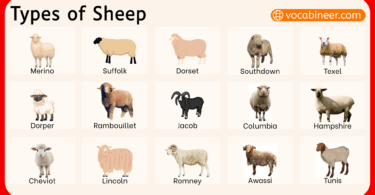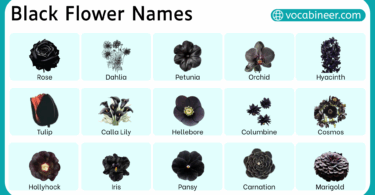Mammals are warm-blooded animals with hair or fur, and they feed their young with milk. They live in forests, oceans, grasslands, and even cold regions. Their variety is striking, from elephants and whales to lions, dolphins, and other unique species that shape the balance of life. Learning mammal animals name: complete list with their pictures helps readers talk naturally about animals in school, travel, and science topics.
In This Page
List of Common Mammal Animals with Pictures
Mammals are warm-blooded animals that have hair or fur and feed their young with milk. They live in many habitats — from forests and deserts to oceans and cities. Below is a list of common mammal animals.
- Dog: Loyal pet that barks and helps humans as a guard or companion.
- Cat: Small, playful pet that meows and loves to stay indoors.
- Cow: Farm mammal that gives milk used for dairy products.
- Horse: Strong animal used for riding, transport, and farm work.
- Goat: Hardy farm mammal raised for milk, meat, and skin.
- Sheep: Wool-covered animal kept for fleece, milk, and meat.
- Pig: Intelligent farm animal raised for pork and leather.
- Elephant: Largest land mammal with a trunk used for eating and lifting.
- Lion: Wild big cat called the “king of the jungle.”
- Tiger: Striped wild cat that hunts in Asian forests.
- Bear: Large, furry mammal that eats plants, fish, and small animals.
- Monkey: Smart and playful mammal that lives mostly in trees.
- Kangaroo: Australian animal that hops and carries its baby in a pouch.
- Giraffe: Tall African mammal with a long neck for eating high leaves.
- Deer: Graceful mammal with antlers, found in forests and grasslands.
- Rabbit: Small, fast mammal with long ears and soft fur.
- Camel: Desert mammal with humps that store fat for long travel.
- Fox: Small, clever mammal known for its bushy tail.
- Wolf: Wild relative of the dog that lives and hunts in packs.
- Dolphin: Smart sea mammal that communicates using clicks and whistles.
- Whale: Giant ocean mammal that breathes air and sings underwater.
- Bat: Only mammal that can fly, active mainly at night.
- Mouse: Small rodent that squeaks and lives near humans.
- Rat: Larger rodent known for survival skills in cities and farms.
- Hippopotamus: Big water mammal that spends most of its time in rivers.
- Zebra: African mammal with black and white stripes.
- Leopard: Fast wild cat with spotted fur for camouflage.
- Panda: Black-and-white bear that eats mostly bamboo.
- Gorilla: Strong primate that lives in African forests.
- Chimpanzee: Intelligent mammal closely related to humans.

Wild Mammal Animals Name
Wild mammals live freely in forests, mountains, deserts, and grasslands. They hunt, graze, or climb to survive without human help. Below is a list of wild mammal animals.
- Lion: Large wild cat known for its golden mane and powerful roar.
- Tiger: Striped predator found in Asian forests and grasslands.
- Leopard: Fast, spotted cat that hunts in jungles and savannas.
- Elephant: Giant land mammal with a trunk and large ears.
- Zebra: African mammal with black and white stripes for camouflage.
- Giraffe: Tall mammal with a long neck that eats tree leaves.
- Wolf: Wild dog that lives and hunts in packs.
- Fox: Small, clever wild mammal with reddish fur and a bushy tail.
- Bear: Strong animal that eats fish, fruits, and honey in forests.
- Deer: Gentle forest mammal with antlers and graceful movement.
- Bison: Large grazing mammal that lives on grasslands in herds.
- Rhinoceros: Big gray mammal with one or two horns on its nose.
- Hippopotamus: Heavy water-loving mammal that lives in African rivers.
- Gorilla: Strong primate that lives in African rainforests.
- Chimpanzee: Smart forest mammal closely related to humans.
- Kangaroo: Wild Australian mammal that hops and carries its baby in a pouch.
- Panda: Black-and-white bear that eats bamboo in mountain forests.
- Cheetah: Fastest land animal, known for its speed while chasing prey.
- Moose: Large deer with broad antlers, found in cold forests.
- Antelope: Fast-running grazing mammal found in open plains.
Aquatic Mammal Animals Name
Aquatic mammals are warm-blooded animals that live in or around water. They breathe air through lungs but spend most of their time swimming, diving, or hunting underwater. Below is a list of common aquatic mammal names.
- Dolphin: Smart sea mammal known for jumping, playing, and using sound to communicate.
- Whale: The largest ocean mammal that sings and migrates across seas.
- Seal: Smooth-bodied marine mammal that rests on rocks and swims with flippers.
- Sea Lion: Playful animal with small ears that can walk on land using its flippers.
- Walrus: Big sea mammal with long tusks and whiskers that lives in cold regions.
- Otter: Small aquatic mammal that floats on its back and eats fish.
- Manatee: Gentle sea mammal called the “sea cow” that grazes on underwater plants.
- Dugong: Marine mammal similar to a manatee, found in warm coastal waters.
- Beaver: Semi-aquatic mammal that builds dams and lodges using wood.
- Platypus: Egg-laying mammal with a duck-like bill and webbed feet.
- Sea Otter: Marine otter that uses stones to crack open shells while floating.
- Narwhal: Arctic whale with a long, spiral tusk known as the “unicorn of the sea.”
- Porpoise: Small, dolphin-like marine mammal with a short snout and curved dorsal fin.
- Pygmy Sperm Whale: Small whale that dives deep to hunt for squid.
- River Dolphin: Freshwater dolphin species that live in rivers like the Amazon and Ganges.
Flying Mammal Animals Name
Flying mammals are animals that can fly or glide through the air. Most use wings or skin flaps to move between trees or travel long distances. Below is a list of common flying mammal names.
- Bat: The only true flying mammal; uses wings made of thin skin to fly at night.
- Flying Fox: A large fruit bat with long wings and a fox-like face found in tropical regions.
- Flying Squirrel: Small gliding mammal that uses skin flaps between its legs to glide.
- Sugar Glider: Tiny nocturnal glider that feeds on nectar and insects.
- Colugo: Also called a flying lemur, glides long distances using large skin membranes.
- Greater Mouse-Eared Bat: Common European bat that hunts insects at night.
- Egyptian Fruit Bat: Feeds on fruits and helps pollinate plants in tropical forests.
- Honduran White Bat: Small white bat that hides under banana leaves.
- Brown Long-Eared Bat: Recognized by its long ears and slow flight in forests.
- Little Brown Bat: Common North American bat that eats mosquitoes and small bugs.
- Pallid Bat: Pale desert bat that hunts scorpions and insects on the ground.
- Spectacled Flying Fox: Large fruit bat with golden fur and dark eye markings.
- Indian Flying Fox: One of the biggest bats in the world, found across South Asia.
- Bumblebee Bat: The world’s smallest mammal, barely the size of a thumb.
- Short-Tailed Fruit Bat: Tropical bat that feeds on fruits and helps spread seeds.
List of Rodent Mammal Animals
Rodents are small mammals with sharp front teeth for gnawing. They form the largest group of mammals worldwide.
- Mouse
- Rat
- Squirrel
- Beaver
- Hamster
- Guinea Pig
- Porcupine
- Chipmunk
- Capybara
- Chinchilla
- Gerbil
- Prairie Dog
- Vole
- Lemming
- Agouti
- Gopher
- Marmot
- Nutria
- Patagonian Mara
- Mole Rat
Marsupial Mammal Animals Name
Marsupial mammals are animals that carry and nurse their babies in a pouch after birth. They are mostly found in Australia and nearby islands, but some live in the Americas. Below is a list of common marsupial mammal names.
- Kangaroo: Large hopping animal from Australia that carries its baby, called a joey, in a pouch.
- Koala: Tree-dwelling marsupial that eats eucalyptus leaves and sleeps up to 20 hours a day.
- Wallaby: Small relative of the kangaroo that lives in grassy and rocky areas.
- Wombat: Sturdy, burrowing marsupial with a short tail and strong claws for digging.
- Tasmanian Devil: Fierce, meat-eating marsupial from Tasmania known for its loud growl.
- Opossum: The only marsupial found in North America; plays dead to avoid predators.
- Sugar Glider: Tiny, gliding marsupial that feeds on nectar and insects at night.
- Quokka: Small, smiling marsupial from Australia often seen on Rottnest Island.
- Bandicoot: Nocturnal marsupial with a pointed nose that digs for insects and roots.
- Bilby: Desert-dwelling marsupial with long ears and silky fur, sometimes called the “rabbit-eared bandicoot.”
- Quoll: Spotted marsupial predator that hunts insects, birds, and small mammals.
- Tree Kangaroo: Arboreal marsupial that climbs trees and feeds on leaves and fruits.
- Numbat: Termite-eating marsupial with a long tongue and striped back.
- Pademelon: Small forest marsupial related to wallabies, found in Tasmania and New Guinea.
- Antechinus: Tiny marsupial that looks like a mouse and eats insects.
Primate Mammal Animals Name
Primates are intelligent mammals with flexible hands, forward-facing eyes, and strong family bonds. They live mostly in forests and warm regions. Below is a list of common primate mammal names with short, simple descriptions.
- Monkey: Smart and playful primate that lives in trees and eats fruits and insects.
- Gorilla: Largest primate that lives in African forests and walks on its knuckles.
- Chimpanzee: Intelligent primate closely related to humans; uses tools to get food.
- Orangutan: Tree-dwelling primate from Asia with long arms and reddish-brown hair.
- Baboon: Ground-dwelling monkey with a dog-like face found in African savannas.
- Lemur: Small primate with large eyes and a long tail, native to Madagascar.
- Gibbon: Fast-moving ape that swings between trees using long arms.
- Macaque: Medium-sized monkey found in Asia; known for living close to humans.
- Tamarin: Tiny monkey with colorful fur and long whiskers, found in tropical forests.
- Capuchin Monkey: Smart monkey from South America often seen using tools.
- Mandrill: Brightly colored monkey with a red and blue face, found in African rainforests.
- Howler Monkey: Loud-voiced monkey from Central and South America that roars through the forest.
- Spider Monkey: Long-limbed primate that uses its tail to swing through trees.
- Saki Monkey: South American primate with thick fur and strong jaws for cracking nuts.
Arctic Mammal Animals Name
Arctic mammals are animals that live in cold polar regions. They have thick fur or fat layers to stay warm and survive freezing temperatures. Below is a list of common Arctic mammal names.
- Polar Bear: The largest land carnivore that hunts seals on Arctic ice.
- Arctic Fox: Small white fox that changes fur color with the seasons.
- Walrus: Big sea mammal with long tusks and thick skin for cold waters.
- Caribou: Wild reindeer that migrates long distances across the Arctic tundra.
- Musk Ox: Large, shaggy mammal with curved horns that lives in icy grasslands.
- Arctic Hare: White-furred hare that blends into snowy landscapes.
- Arctic Wolf: Strong, white-coated wolf that hunts in packs on frozen lands.
- Beluga Whale: White whale that lives in Arctic seas and uses sound to communicate.
- Narwhal: Arctic whale with a long spiral tusk known as the “sea unicorn.”
- Seal: Smooth-skinned sea mammal that rests on ice and swims in cold waters.
- Bowhead Whale: Large Arctic whale that can break sea ice with its head.
- Ermine: Small weasel that turns white in winter for camouflage.
- Lemming: Tiny rodent that burrows under snow and feeds on plants.
- Snowshoe Hare: Arctic hare species with large feet for moving on snow.
- Ringed Seal: Common Arctic seal that gives birth in snow dens.
Desert Mammal Animals Name
Desert mammals live in hot, dry places with little water. They have special body features to survive extreme heat and long dry periods. Below is a list of common desert mammal names.
- Camel: Desert mammal with humps that store fat and help survive without water.
- Fennec Fox: Small fox with large ears that release body heat.
- Kangaroo Rat: Tiny desert rodent that gets water from seeds instead of drinking.
- Meerkat: Small social mammal that stands upright to watch for danger.
- Jerboa: Jumping desert rodent with long legs and a tufted tail.
- Dromedary Camel: One-humped camel known for long-distance travel in sandy deserts.
- Addax Antelope: White-coated antelope that survives desert heat with little water.
- Arabian Oryx: Pale desert antelope with long, straight horns.
- Desert Hedgehog: Small hedgehog that hides in burrows during the day.
- Bat-Eared Fox: Fox with big ears for cooling and hearing insects underground.
- Rock Hyrax: Small mammal that lives in rocky desert areas and sunbathes for warmth.
- Sand Cat: Wild cat that blends into desert sand and hunts at night.
- Gerbil: Small burrowing rodent common in dry, sandy environments.
- Armadillo: Desert mammal with a hard shell that curls into a ball for protection.
- Ground Squirrel: Burrowing rodent that stores food underground to survive the dry season.
Conclusion about Mammal Animals Name
Learning mammal animals name with their pictures helps learners understand animal diversity better. From domestic species to aquatic giants, mammals live in almost every habitat. By recognizing these names, students and readers can talk more confidently about animals in school, travel, and science.
FAQs
Common mammals include dogs, cats, cows, goats, sheep, and rabbits, as they live close to people and are widely recognized.
The blue whale is the largest mammal on Earth, reaching more than 90 feet long and weighing over 100 tons.
Yes, mammals like dolphins, whales, seals, and walruses live in water but still breathe air through lungs.
Only bats are true flying mammals. They use wings made of stretched skin to move in the air.
Most mammals give birth to live young, but a few, like the platypus and echidna, lay eggs and then nurse their babies with milk.
Read More




